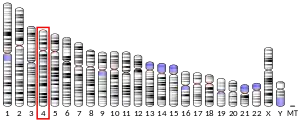Chemokine (C-X-C motif) ligand 13 (CXCL13), also known as B lymphocyte chemoattractant (BLC) or B cell-attracting chemokine 1 (BCA-1), is a protein ligand that in humans is encoded by the CXCL13 gene.[5][6]
Function
CXCL13 is a small chemokine belonging to the CXC chemokine family. As its other names suggest, this chemokine is selectively chemotactic for B cells belonging to both the B-1 and B-2 subsets, and elicits its effects by interacting with chemokine receptor CXCR5.[5][7] CXCL13 and its receptor CXCR5 control the organization of B cells within follicles of lymphoid tissues[8] and is expressed highly in the liver, spleen, lymph nodes, and gut of humans.[5] The gene for CXCL13 is located on human chromosome 4 in a cluster of other CXC chemokines.[6]
In T lymphocytes, CXCL13 expression is thought to reflect a germinal center origin of the T cell, particularly a subset of T cells called follicular B helper T cells (or TFH cells). Hence, expression of CXCL13 in T-cell lymphomas, such as angioimmunoblastic T-cell lymphoma, is thought to reflect a germinal center origin of the neoplastic T-cells.[9]
References
- 1 2 3 GRCh38: Ensembl release 89: ENSG00000156234 - Ensembl, May 2017
- 1 2 3 GRCm38: Ensembl release 89: ENSMUSG00000023078 - Ensembl, May 2017
- ↑ "Human PubMed Reference:". National Center for Biotechnology Information, U.S. National Library of Medicine.
- ↑ "Mouse PubMed Reference:". National Center for Biotechnology Information, U.S. National Library of Medicine.
- 1 2 3 Legler DF, Loetscher M, Roos RS, Clark-Lewis I, Baggiolini M, Moser B (February 1998). "B cell-attracting chemokine 1, a human CXC chemokine expressed in lymphoid tissues, selectively attracts B lymphocytes via BLR1/CXCR5". J. Exp. Med. 187 (4): 655–60. doi:10.1084/jem.187.4.655. PMC 2212150. PMID 9463416.
- 1 2 Gunn MD, Ngo VN, Ansel KM, Ekland EH, Cyster JG, Williams LT (February 1998). "A B-cell-homing chemokine made in lymphoid follicles activates Burkitt's lymphoma receptor-1". Nature. 391 (6669): 799–803. Bibcode:1998Natur.391..799G. doi:10.1038/35876. PMID 9486651. S2CID 4373691.
- ↑ Ansel KM, Harris RB, Cyster JG (January 2002). "CXCL13 is required for B1 cell homing, natural antibody production, and body cavity immunity". Immunity. 16 (1): 67–76. doi:10.1016/S1074-7613(01)00257-6. PMID 11825566.
- ↑ Ansel KM, Ngo VN, Hyman PL, Luther SA, Förster R, Sedgwick JD, Browning JL, Lipp M, Cyster JG (July 2000). "A chemokine-driven positive feedback loop organizes lymphoid follicles". Nature. 406 (6793): 309–14. doi:10.1038/35018581. PMID 10917533. S2CID 4369622.
- ↑ de Leval L, Rickman DS, Thielen C, Reynies A, Huang YL, Delsol G, Lamant L, Leroy K, Brière J, Molina T, Berger F, Gisselbrecht C, Xerri L, Gaulard P (June 2007). "The gene expression profile of nodal peripheral T-cell lymphoma demonstrates a molecular link between angioimmunoblastic T-cell lymphoma (AITL) and follicular helper T (TFH) cells". Blood. 109 (11): 4952–63. doi:10.1182/blood-2006-10-055145. PMID 17284527.
External links
- Human CXCL13 genome location and CXCL13 gene details page in the UCSC Genome Browser.
- Overview of all the structural information available in the PDB for UniProt: O43927 (C-X-C motif chemokine 13) at the PDBe-KB.




